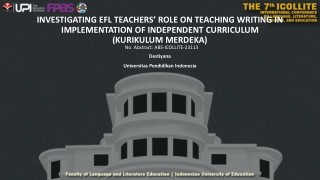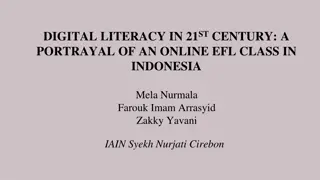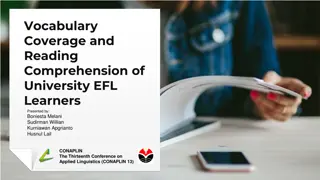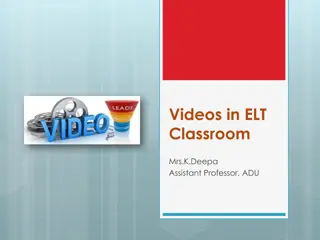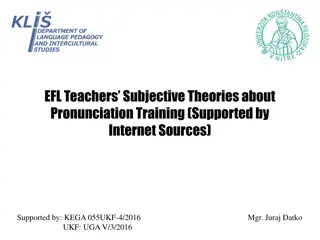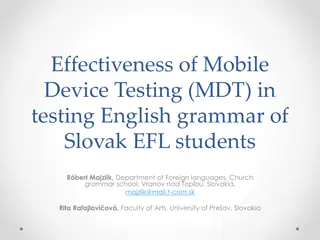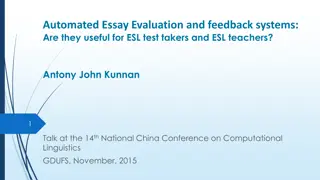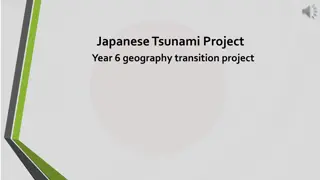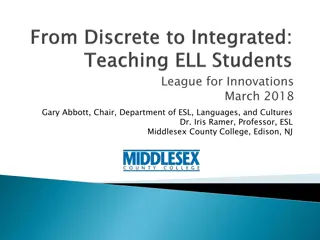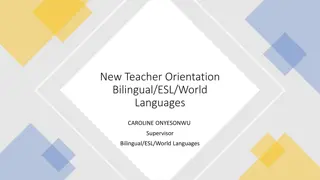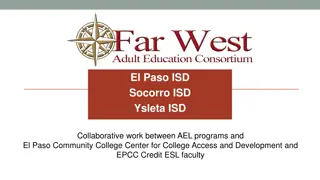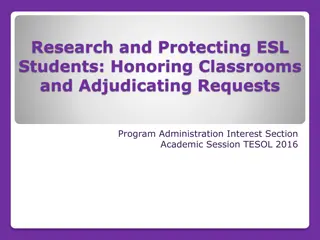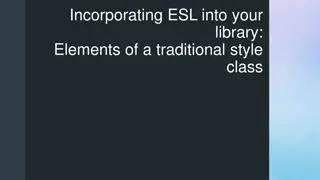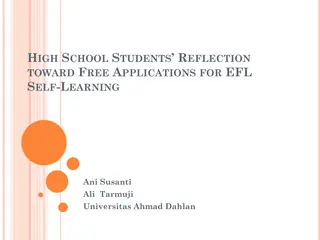Exploring World Englishes in ESL/EFL Classrooms: A Perspective from Japan
This presentation discusses the incorporation of World Englishes into ESL/EFL classrooms, focusing on Japan's context. It covers the concept of World Englishes, the comparison with Inner-circle English, personal experiences, and the value of teachers using World Englishes in language education. The challenges faced by Japanese learners and the importance of promoting open-mindedness and self-confidence through diverse English variants are highlighted.
Download Presentation

Please find below an Image/Link to download the presentation.
The content on the website is provided AS IS for your information and personal use only. It may not be sold, licensed, or shared on other websites without obtaining consent from the author.If you encounter any issues during the download, it is possible that the publisher has removed the file from their server.
You are allowed to download the files provided on this website for personal or commercial use, subject to the condition that they are used lawfully. All files are the property of their respective owners.
The content on the website is provided AS IS for your information and personal use only. It may not be sold, licensed, or shared on other websites without obtaining consent from the author.
E N D
Presentation Transcript
Incorporating World Incorporating World Englishes into ESL / EFL classrooms into ESL / EFL classrooms Yuya Kurata (Japan) Saint Mary's University, IMTE TEFL NS, 2019 Fall Conference, 16 November Englishes
Questions Questions 1. Wait it s on the tip of my throat her name is Fiona. tongue 2. Can you open the light? turn on
Outline Outline World Englishes World Englishes vs. Inner-circle English in Japan Inner-Circle English personal experience The Value of Teachers using World Englishes: why? World Englishes into ESL / EFL classrooms(1)(2):How? Conclusion
What is What is World World Englishes Englishes? ? The Expanding Circle e.g. China / Egypt / Indonesia / Japan / Korea / Nepal / Saudi Arabia refers to different forms and varieties of English used in various sociolinguistic contexts in different parts of the world. three types of varieties estimated number of English speakers is at least 800 million The Outer Circle e.g. India / Malaysia/ Nigeria / Kenya / Philippines / Sri Lanka / Tanzania / Zambia The Inner Circle e.g. USA / UK / Canada / Australia / New Zealand (created from Kachru, 1992)
World World Englishes Englishes vs. Inner vs. Inner- -circle English in Japan circle English in Japan Textbooks in Japan tend to be predominantly American and also British English The Japanese government launched English program (JET) Assistant English teachers from Inner Circle countries in percentage (Suginaga, 2012) year 1987 2000 2019 The percentage of AET from Inner Circle countries 100% 98% 89% (Matsuda, 2003; The Council of Local Authorities for International Relations (CLAIR), 2019) (http://jetprogramme.org/en/countries/)
Inner Inner- -Circle English Personal Experience Circle English Personal Experience Japanese accent (Far from Inner-circle English accent) Less competent at speaking(pronunciation, fluency, appropriacy, etc.) Low self-esteem High Anxiety
The Value of Teachers using World The Value of Teachers using World Englishes ESL / EFL classrooms: why? ESL / EFL classrooms: why? Englishes in in To: build open-mindedness and self-confidence have empathy and tolerance for unfamiliar Englishes Global competences
How to Bring World How to Bring World Englishes into ESL / EFL classrooms (1) into ESL / EFL classrooms (1) Englishes 1. Website / YouTube / Podcast India: https://www.ndtv.com/ (Website) Singapore: https://www.channelnewsasia.com/news/videos (Website) The International Dialects of English Archive (Website) https://www.dialectsarchive.com/ Accents of English Around the World (YouTube) https://www.youtube.com/watch?v=vpcG-xqPgRM CNN10: https://www.cnn.com/cnn10 (YouTube / Podcast)
How to Bring World How to Bring World Englishes into ESL / EFL classrooms (2) into ESL / EFL classrooms (2) Englishes 2. Video call (Skype) Talk with outer and expanding circle people. e.g. Online English conversation
Conclusion Conclusion English is one of the elements for global citizenship Some benefits (open-mindedness / confidence / empathy / tolerance) Removing the Inner-Circle Englishes / replacing them with the other circle Englishes World Englishes Add some benefits and enrich "English"
How do you feel these sentences? How do you feel these sentences? Wait it s on the tip of my throat her name is Fiona. Can you open the light?
References References The Council of Local Authorities for International Relations. 2019. Participating Countries. JET Program, http://jetprogramme.org/en/countries/. Accessed on 14 November. Farrell, Thomas S. C., and Sonia Martin. 2009. To Teach Standard English or World Englishes? A Balanced Approach to Instruction. English Teaching Forum 2. Jenkins, Jennifer. 2003. World Englishes: A Resource Book for Students. Psychology Press. Kachru, Braj B. 1992. Teaching World Englishes. The Other Tongue: English across Cultures 2: 355 66. Kubota, Ryuko, and Lori Ward. 2000. Exploring Linguistic Diversity through World Englishes. The English Journal 89 (6): 80 86. Matsuda, Aya. 2003. Incorporating World Englishes in Teaching English as an International Language. TESOL Quarterly 37 (4): 719 29. Suginaga, Jackie. 2012. World Englishes in Japan A Sociolinguistic Perspective. The Faculty Journal of Komazawa Women s University 19: 169 76.


